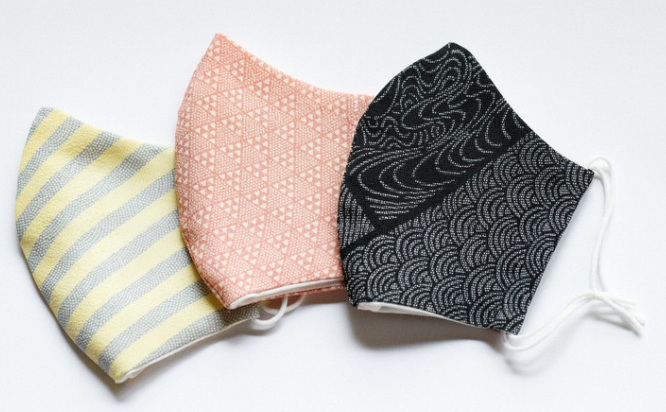
Category: SERVICES
Country: Japan
October 19, 2021 (Mainichi Japan)
Masks with Edo Komon patterns created at Hirose Dyeworks, including one with scale designs believed to ward off evil pictured at the center, is seen in Tokyo's Shinjuku Ward on July 8, 2020. (Mainichi/Kota Yoshida) =Click/tap photo for more images.
TOKYO -- Upon entering the "itaba" workshop space at Hirose Dyeworks in Tokyo, snow white silk fabrics could be seen spread out atop narrow seven-meter-long planks of Japanese fir wood lined up in a row. Craftsman Yuichi Hirose, 42, was carefully applying paste to the silk cloth called "chirimen," as part of the dyeing process to create fine kimono patterns known as "Edo Komon."
On this rainy day in July, Hirose explained to us the different steps involved in this traditional dyeing technique. "Days like today with high humidity are perfect for stencil dyeing," the craftsman said.
Kimonos are traditional attire that are a representative element of Japanese culture. While there are woven fabric, dyed cloth and other various types of kimono material found across the country, Hirose Dyeworks in the capital's Shinjuku Ward has continued to create fabrics employing the "Edo Komon" dyeing technique.
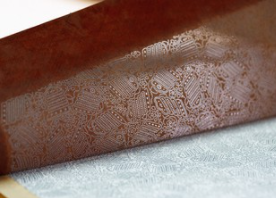
Fabric with paste applied using a paper stencil for the "yoroi" Edo Komon pattern, based on traditional samurai armor, is seen at Hirose Dyeworks in Tokyo's Shinjuku Ward on July 8, 2020. (Mainichi/Kota Yoshida)
Edo Komon is known for its extremely small patterns which cannot be seen from afar. They were used in "kamishimo" formal dresses worn by samurai during the Edo period (1603-1867). The design was spread as a form of resistance against bans on luxury targeting samurai and common folk, which were issued frequently by the Tokugawa shogunate. Even if fancy patterns were prohibited, if they were small, the fabric would appear plain from a distance. It can be said that the traditional patterns are the product of the wit of the Edo people.
Paper stencils are used to attach patterns onto the fabric. Ise Katagami pattern paper, which was developed in the western Japan area that is currently Mie Prefecture, is also all handmade by those specializing in the craft. Three pieces of firm Mino washi paper are affixed to one another with "kakishibu" dye made from fermenting juice extracted from astringent persimmons. A superfine chisel is then used to carve detailed patterns onto the strengthened paper.
Hirose showed us the steps leading to the creation of a "yoroi" pattern, which is based on traditional armor worn by medieval samurai on battlegrounds. The paper stencil was placed on top of the silk fabric, and a hinoki cypress utensil was used to spread dye resistant paste of a light ink black color flat over the stencil. When the paper stencil was peeled off gently, paste was left on the cloth according to the stencil's pattern. While the width of one roll of kimono fabric is about 37 centimeters, it has a length stretching up to some 13 meters. The chain of patterns is applied in order, allowing no room for any misalignments or discontinuations up until the very end.
Yuichi Hirose, fourth-generation head of Hirose Dyeworks, is seen applying paste to silk fabric at the Edo Komon workshop in Tokyo's Shinjuku Ward on July 8, 2020. (Mainichi/Kota Yoshida) =Click/tap photo for more images.
"The more peace of mind you've achieved, the better the completed work becomes. Though it seems like a simple task, the state of the air at the time, as well as the craftsperson's mental state has subtle influences on the work," said Hirose, the fourth-generation head of Hirose Dyeworks who has been working in the business for 20 years.
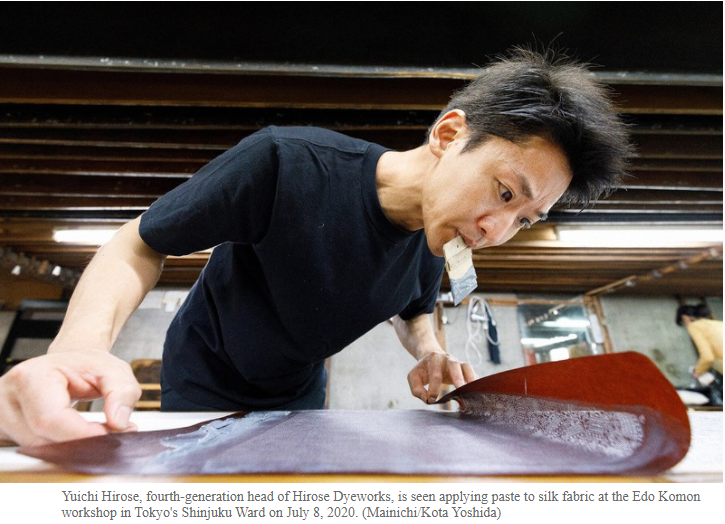
The silk fabric, onto which paste has been applied, is then dyed into one color once the paste is dry. In the end, when the paste is washed off, the snow-white areas that were left undyed emerge distinctly.
"The simple patterns that are themed after objects found in our surroundings are imbued with a faintly graceful quality. I think that the beauty of the Edo Komon craft lies here," said Hirose.
The wisdom and skills of the people who lived during Edo are contained in these small designs.
(Japanese original by Tadahiko Mori, The Mainichi Staff Writer)
* * *
The Japanese version of this article was originally published on July 28, 2020, and the ages of individuals indicated in the story are as of the publishing date.
* * *
Steps leading to the creation of Edo Komon
1. Patterns are carved by hand on Japanese washi paper fortified by persimmon tannin.

Fabric with paste applied using a paper stencil is seen at Hirose Dyeworks in Tokyo's Shinjuku Ward on July 8, 2020. (Mainichi/Kota Yoshida) =Click/tap photo for more images.
2. The paper stencil is placed on a white fabric, and dye resistant paste is applied. This is the most important step of the entire process.
3. Coloring paste is created by steaming a mixture of glutinous rice powder and rice bran, and adding dye to paste that is kneaded well.
4. The coloring paste containing the dye is applied to the whole fabric to add the background color.
5. The fabric is placed in a cypress steamer for around 30 minutes at a temperature of 90 to 95 degrees Celsius so the color sets in.
6. The fabric is washed with water to remove the paste. The patterns and colors emerge more distinctly when thoroughly rinsed numerous times.
7. The fabric is dried quickly in the sun.
* * *
Various patterns
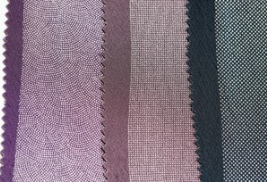
Fabrics employing three major Edo Komon patterns; from left, the "same" sharkskin-like pattern, the "toshi" (literally meaning 'continuous run') pattern, and the "gyogi" (literally meaning 'manners') pattern, are seen at Hirose Dyeworks in Tokyo's Shinjuku Ward on July 8, 2020. (Mainichi/Kota Yoshida)
Hirose Dyeworks creates the three major traditional patterns of the "same" sharkskin-like pattern, the "gyogi" (literally meaning 'manners') pattern and the "toshi" (literally meaning 'continuous run') pattern. It also has casual designs, as well as playful patterns, such as a chili pepper design designed to ward off bugs, a pattern named "white radish and grater" -- which can also signify "removing ham actors" through word play -- and a "nanten" heavenly bamboo pattern that can mean "altering hardship." Other designs contain the words "peace at home" and "perpetual youth and longevity."
In two rooms at Hirose Dyeworks, there are apparently 2,000 to 3,000 types of paper stencils dating back to the Edo period.
* * *
Spreading Edo Komon to the world
In recent years, Hirose has been working on new products, one of which is a silk stole, so that people who do not wear kimono and foreigners can also appreciate the traditional craft. The brand was named "comment?" a play on the words "komon" and the French word meaning "How is it?" The brand was launched after Hirose demonstrated part of the Edo Komon dyeing process in France, and some of the stoles adopt designs devised by students at local art universities there. "They think up designs that Japanese people don't come up with," Hirose said. Masks with Edo Komon designs have also been created amid the coronavirus pandemic.
* * *
Hirose Dyeworks is located at 4-32-5 Nakaochiai in Tokyo's Shinjuku Ward.
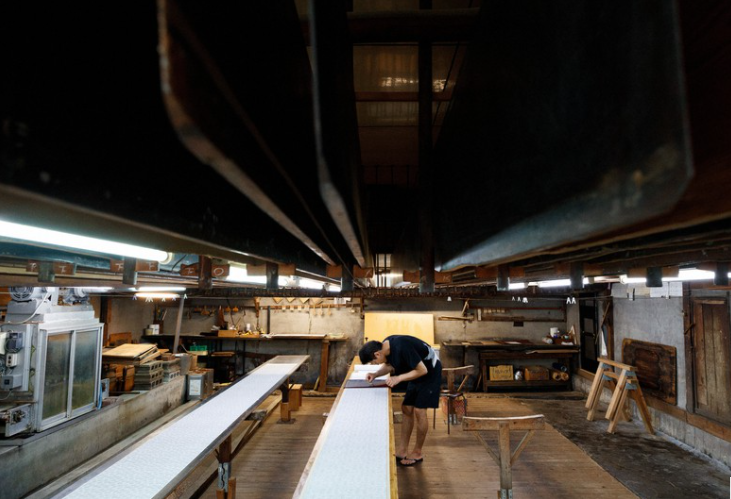
Yuichi Hirose, fourth-generation head of Hirose Dyeworks, is seen inside the "itaba" workshop space at Hirose Dyeworks in Tokyo's Shinjuku Ward on July 8, 2020. Silk fabrics are smoothly spread out on top of 7-meter planks of Japanese fir wood. (Mainichi/Kota Yoshida) =Click/tap photo for more images.
2021 marks the 103rd anniversary of the workshop's establishment, and it has been over 90 years since it was moved to its current location. The "itaba" workshop space has remained basically unchanged over the past 90 years. The Myoshoji and Kanda rivers flow nearby, and it is said that the fabrics were rinsed in these rivers until the 1950s.
The workshop's official website is at http://komonhirose.co.jp/en/index.html (in English) and at http://komonhirose.co.jp/ (in Japanese). The online store is at https://hirosedyeworks.myshopify.com/?d=n
* * *
Hirose Dyeworks is also introduced as part of the Tokyo Metropolitan Government's Edo Tokyo Kirari project which, based on the concept "old meets new," profiles brands at the link https://en.edotokyokirari.jp/project/fashion/hirose-dyeworks/
* * *
Enchanting Edo
The "Enchanting Edo" series highlights Japanese traditions, crafts, artisanal techniques and culture that date back several hundred years. Stories offer a glimpse into old shops in Japan's capital, which are all searching for ways to protect long-established skills and talent, while also keeping them alive in the modern day.
The original Japanese versions of the articles, which can be reached via the link located at the top right below the headline, include "furigana" phonetic characters to assist in reading all kanji characters that appear in the text. The user-friendly text primarily targets elementary school children in Japan, but can also be used by non-Japanese readers learning intermediate-level Japanese. We encourage any readers interested in Japanese culture, language, or both to make full use of our series.
The next "Enchanting Edo" story on traditional "kumade" rakes, symbols of raking in a fortune, will be published on Nov. 2.
Courtesy: https://mainichi.jp/english/articles/20211015/p2a/00m/0et/037000c
Copyrights © 2025 GLOBAL TEXTILE SOURCE. All rights reserved.